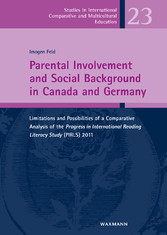Suchen und Finden
Service
Mehr zum Inhalt

Parental Involvement and Social Background in Canada and Germany - Limitations and Possibilities of a Comparative Analysis of the Progress in International Reading Literacy Study (PIRLS) 2011
Book Cover
1
Imprint
4
Table of Contents
5
Abstract
9
Abstract (in German)
11
Introduction
13
1. Canada and Germany: Educational Systems
18
1.1 Canada
20
1.1.1 A Brief History of the Canadian Education System
22
1.1.2 Country Specifics
26
1.1.2.1 Canadian Federalism
26
1.1.2.2 Quebec
27
1.1.2.3 Aboriginal People (First Nations, Inuit und Métis)
29
1.1.2.4 Immigration
32
1.1.2.5 Multiculturalism
34
1.1.3 Canada's Education System
36
1.1.3.1 The Structure of the Canadian Education System
36
1.1.3.2 Specifics of the Canadian Education System
40
1.1.3.2.1 Multicultural Education
40
1.1.3.2.2 School Boards and Councils
41
1.1.3.2.3 Home-Schooling
43
1.1.3.3 Curriculum and School Life
43
1.2 Germany
46
1.2.1 A Brief History of Germany's Education System
47
1.2.2 Country Specifics
51
1.2.2.1 German Federalism
51
1.2.2.2 Immigration
54
1.2.3 Germany's Educational System
58
1.2.3.1 Structure of the Educational System
58
1.2.3.2 Specifics of the Educational System
62
1.2.3.2.1 School Tracking
62
1.2.3.2.2 Stundents with Special Needs
65
1.2.3.2.3 Parents' Councils
66
1.2.3.2.4 Half-day and Full-time Schooling
66
1.2.3.3 Curriculum and School Life
68
1.3 Similarities and Differences between Canada and Germany
69
2. The Relevance of the Home in a Student's School Life
75
2.1 Parental Involvement and Related Theories
76
2.1.1 Parent Involvement
78
2.1.2 Theories Beyond Parental Involvement
83
2.1.2.1 Self-Determination Theory and other Theories
84
2.1.2.2 Authoritative Parental Control
86
2.1.2.3 Social Capital
89
2.1.3 Cultural Capital, Process, Structural Factors, Direct and Indirect Effects
92
2.1.3.1 Bourdieu's Theories of Cultural Capital and Habitus
92
2.1.3.2 Indirect and Direct Effects
94
2.1.3.3 Process and Structural Factors
95
2.1.4 Putting Parental Involvement into Context
97
2.2 The Theoretical Model of this Study
104
3. The Current State of Empirical Research
105
3.1 Parental Factors
105
3.2 International Studies
106
3.3 Studies on the German Education System
114
3.4 Studies on the Canadian Education System
122
3.5 Parental Involvement: High and Low Achievers
125
3.6 Summary of Parental Involvement
129
4. Research Questions and Hypotheses
131
4.1 Description of the Theoretical-Empirical Model
132
4.2 Comparison between Canada and GermanyAn overview of all the research questions and hypotheses can be found in Appendix B.
135
4.3 Comparison between High and Low Achievers
141
4.5 Comparison between Quebec and Ontario
143
4.6 Understanding the Cultural Context
144
5. Method
146
5.1 Data
146
5.1.1 Description of the Data
146
5.1.2 Limitations of the Measurements
149
5.1.3 Challenges Concerning Categorical Variables
150
5.1.4 Estimators for Imputed Data
151
5.1.5 Missing Data, Missing Imputation and Plausible Values
152
5.1.6 Matrix-Sampling Booklet Design and Plausible Values
154
5.2 Methodological Approach
155
5.2.1 Structural Equation Modeling
155
5.2.2 Fit Indices
157
5.2.3 Measurement Invariance
159
6. Results
164
6.1 Description of the Manifest and Latent Variables
164
6.2 Results of Measurement Invariance Testing and Structural Equation Modeling
168
6.2.1 Comparison of the Canadian Provinces and Germany
168
6.2.1.1 Model: Canadian Provinces
171
6.2.1.2 Model: Germany
175
6.2.1.3 Comparison of the Two Models
178
6.2.1.4 Conclusion
180
6.2.2 Differentiating between High and Low Achievers
181
6.2.2.1 Comparison of High and Low Achievers in the Canadian Provinces
182
6.2.2.1.1 Canadian Provinces: High Achievers
182
6.2.2.1.2 Canadian Provinces: Low Achievers
185
6.2.2.1.3 Comparison of the Canadian Provinces: High and Low Achievers
186
6.2.2.2 Comparison of High and Low Achievers in Germany
186
6.2.2.2.1 Germany: High Achievers
188
6.2.2.2.2 Germany: Low Achievers
189
6.2.2.2.3 Comparison between High and Low Achievers in Germany
190
6.2.2.3 Conclusion
191
6.2.3 Comparison between Quebec and Ontario
192
6.3.1 Ontario
193
6.3.2 Quebec
195
6.3.3 Results of the Comparison between Quebec and Ontario
197
6.3.4 Conclusion
197
6.3 Overall Conclusion
198
6.4 Explanations Based on Country Context
200
7. Discussion
203
7.1 General Discussion of the Empirical Results
203
7.2 Advantages and Limitations
207
7.2.1 Advantages
207
7.2.2 Limitations
210
8. Outlook
216
8.1 Recommendations for Future Research
216
8.2 Future Challenges for School and Home
219
References
224
Appendix A Journal ComparisonThis research was conducted by Lena Reininghaus (student assistant).
239
Appendix B Questions and Hypotheses
241
Appendix C Tables
243
List of Figures
245
List of Tables
247
Alle Preise verstehen sich inklusive der gesetzlichen MwSt.








